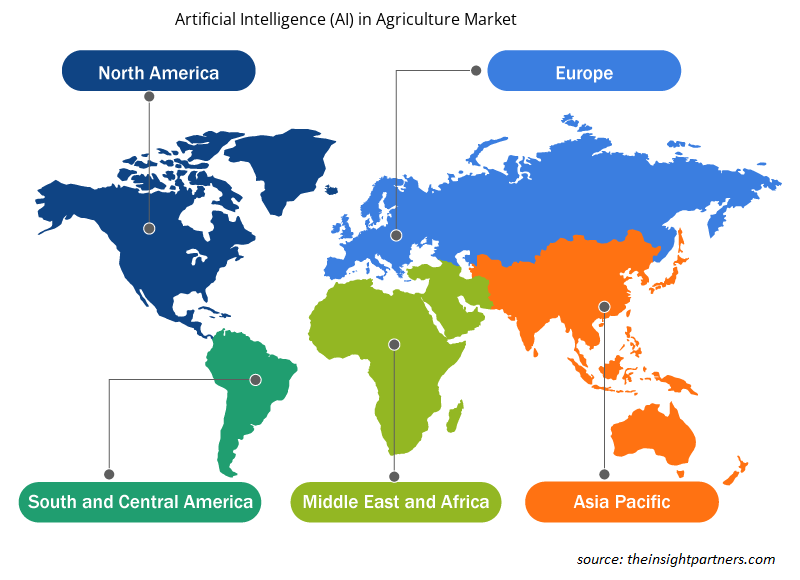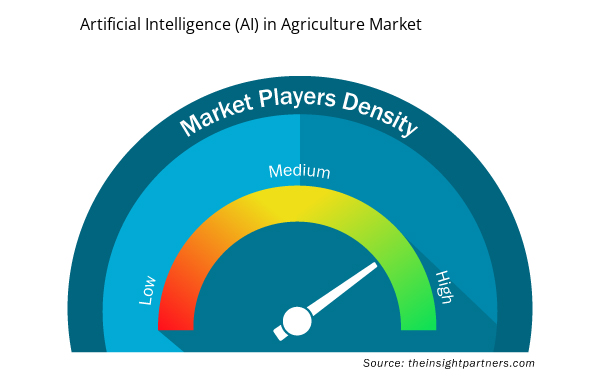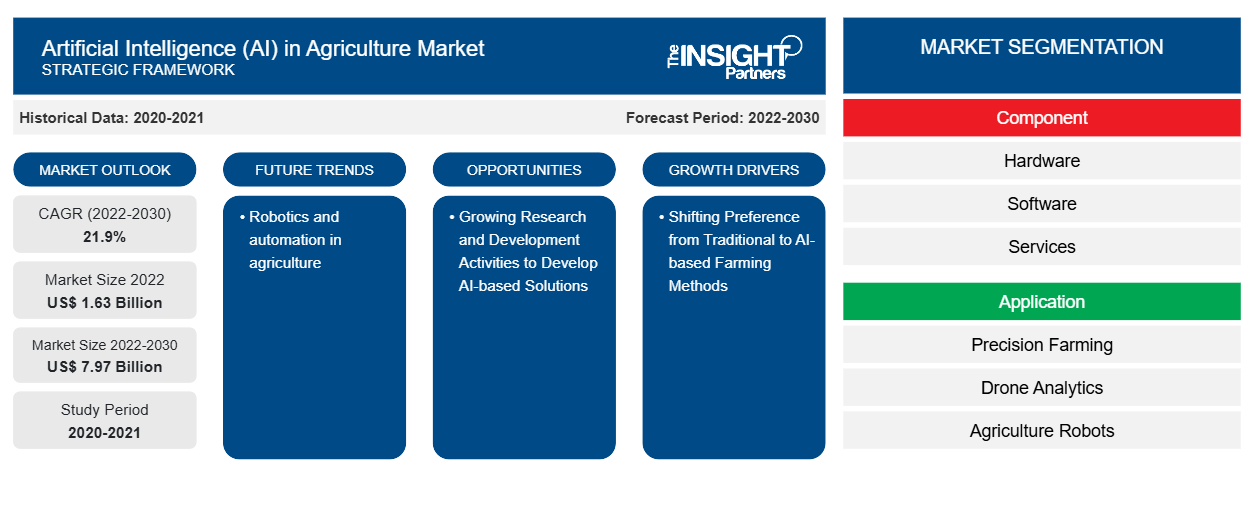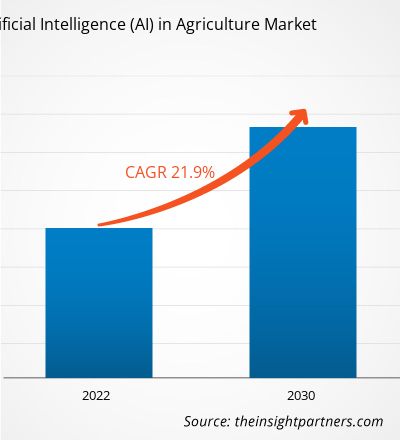Der Markt für künstliche Intelligenz (KI) in der Landwirtschaft hatte im Jahr 2022 einen Wert von 1,63 Milliarden US-Dollar und wird bis 2030 voraussichtlich 7,97 Milliarden US-Dollar erreichen; von 2022 bis 2030 wird eine durchschnittliche jährliche Wachstumsrate (CAGR) von 21,9 % erwartet. Robotik und Automatisierung in der Landwirtschaft werden voraussichtlich weiterhin wichtige Trends auf dem Markt bleiben.
Künstliche Intelligenz (KI) in der Landwirtschaft – Marktanalyse
Der Markt wird durch die Verschiebung der Präferenz von traditionellen zu KI-basierten landwirtschaftlichen Methoden, den zunehmenden Einsatz unbemannter Flugobjekte (UAVs) in der Landwirtschaft und den steigenden Bedarf an Echtzeitanalysen in der Landwirtschaft angetrieben. Aufgrund der zunehmenden staatlichen Unterstützung für die Implementierung von KI-Lösungen wird für den Prognosezeitraum ein Marktwachstum erwartet. Darüber hinaus schaffen wachsende Forschungs- und Entwicklungsaktivitäten zur Entwicklung KI-basierter Lösungen und die zunehmende intelligente Landwirtschaft lukrative Möglichkeiten für den Markt.
Künstliche Intelligenz (KI) in der Landwirtschaft – Marktübersicht
Künstliche Intelligenz (KI) revolutioniert die Landwirtschaft. Predictive Analytics, Computer Vision, maschinelles Lernen und Datenanalyse helfen der Landwirtschaft, Hindernisse zu überwinden und ihr volles Potenzial auszuschöpfen. Der Einsatz von KI in der Landwirtschaft ermöglicht die Erfassung und Analyse von Daten aus einer Vielzahl von Quellen, darunter Bodenbedingungen, Wettermuster, Pflanzengesundheit und historische Daten.
KI-basierte Systeme können Landwirten wertvolle Informationen liefern, um Erträge zu steigern, Abfälle zu reduzieren und Umweltprobleme zu minimieren. Landwirte und Interessenvertreter können datengesteuerte Erkenntnisse und intelligente Entscheidungsfindung nutzen, um die Produktivität zu steigern, die Ressourcennutzung zu optimieren und agronomische Probleme zu lösen. Intelligente Maschinen und Roboter können eingesetzt werden, um monotone Aufgaben in der Landwirtschaft zu automatisieren. Diese Fortschritte helfen landwirtschaftlichen Betrieben, den Arbeitskräftemangel zu beheben und sich auf strategische Planung und Management zu konzentrieren.
Passen Sie diesen Bericht Ihren Anforderungen an
Sie erhalten kostenlos individuelle Anpassungen an jedem Bericht, einschließlich Teilen dieses Berichts oder einer Analyse auf Länderebene, eines Excel-Datenpakets sowie tolle Angebote und Rabatte für Start-ups und Universitäten.
- Holen Sie sich die wichtigsten Markttrends aus diesem Bericht.Dieses KOSTENLOSE Beispiel umfasst eine Datenanalyse von Markttrends bis hin zu Schätzungen und Prognosen.
Künstliche Intelligenz (KI) in der Landwirtschaft – Markttreiber und Chancen
Verschiebung der Präferenz von traditionellen zu KI-basierten landwirtschaftlichen Methoden
Traditionelle Kartoffelbauern in ganz Kanada stehen vor Herausforderungen im Nährstoffmanagement, einem entscheidenden Aspekt der Landwirtschaft, der sich direkt auf die Ernteerträge auswirkt. Die herkömmlichen Methoden der Bodenbehandlung und Blattdüngung sind zwar bis zu einem gewissen Grad wirksam, haben jedoch Einschränkungen, insbesondere bei Nährstoffen, die in späteren Phasen des Kartoffelwachstums benötigt werden. Daher setzen Kartoffelbauern in ganz Kanada KI-Lösungen ein, um den Nährstoffbedarf der Kartoffelpflanze vorherzusagen. Im November 2023 beispielsweise, mit bahnbrechenden Entwicklungen im Agrarsektor, greifen kanadische Kartoffelbauern auf KI zurück, um den Nährstoffbedarf ihrer Pflanzen in Echtzeit zu überwachen und vorherzusagen. Somit treibt die Einführung von KI durch kanadische Landwirte das Wachstum von KI im Agrarmarkt voran.
Wachsende Forschungs- und Entwicklungsaktivitäten zur Entwicklung KI-basierter Lösungen
Großbritannien verfügt über erstklassige Technologie und Forschungskapazitäten und ist weltweit führend in der Entwicklung von KI-gestützten Lösungen. Darüber hinaus nutzen britische Forscher KI, um traditionelle Branchen wie die Landwirtschaft zu revolutionieren. Daten vom Januar 2024 zufolge versuchen Forscher der Harper Adams University, die Landwirtschaft mithilfe von KI nachhaltiger und produktiver zu machen.
Die britische Regierung hat außerdem Fördermittel in Höhe von 39,82 Millionen US-Dollar angekündigt, um die Entwicklung von Projekten im Bereich künstliche Intelligenz in verschiedenen Sektoren wie Landwirtschaft, Mode und Rettungsdienste zu unterstützen. Weitere 5,38 Millionen US-Dollar wurden für Machbarkeitsstudien für 100 Projekte kleiner Unternehmen vergeben, um innovative KI-Ideen zur Steigerung der Produktivität in verschiedenen Sektoren zu fördern. Daher wird erwartet, dass diese staatliche Unterstützung das Wachstum der KI im Agrarmarkt vorantreibt.
Künstliche Intelligenz (KI) in der Landwirtschaft Marktbericht Segmentierungsanalyse
Wichtige Segmente, die zur Ableitung der Marktanalyse künstlicher Intelligenz (KI) in der Landwirtschaft beigetragen haben , sind Komponenten und Anwendungen.
- Basierend auf den Komponenten wird der Markt für künstliche Intelligenz (KI) im Agrarbereich in Hardware, Software und Dienstleistungen unterteilt. Das Hardwaresegment hatte im Jahr 2022 einen größeren Marktanteil.
- In Bezug auf die Anwendung ist der Markt in Präzisionslandwirtschaft , Drohnenanalytik, Landwirtschaftsroboter, Viehüberwachung und andere unterteilt. Das Segment Präzisionslandwirtschaft hatte im Jahr 2022 einen größeren Marktanteil.
Künstliche Intelligenz (KI) in der Landwirtschaft – Marktanteilsanalyse nach Geografie
Der geografische Umfang des Marktberichts über künstliche Intelligenz (KI) in der Landwirtschaft ist hauptsächlich in fünf Regionen unterteilt: Nordamerika, Asien-Pazifik, Europa, Naher Osten und Afrika sowie Süd- und Mittelamerika.
Der Markt im asiatisch-pazifischen Raum wird im Prognosezeitraum voraussichtlich wachsen, da die Nachfrage nach technologisch fortschrittlichen Lösungen steigt. In Ländern wie Australien, wo die landwirtschaftliche Belegschaft schnell altert, ist die Nachfrage nach Fachkräften größer denn je. Die Landwirtschaft mit ihrer Integration modernster Technologien wie KI und maschinellem Lernen ist der Schlüssel, um diese Lücke zu schließen und die Landwirtschaft in die Gegenwart zu bringen. Mehrere australische Landwirte profitieren bereits von den Vorteilen KI-gestützter Systeme. So setzte Sunray Strawberries in Wamuran im Oktober 2023 das automatisierte Überwachungssystem DeepBerry ein. Das System verwendet sowohl visuelle als auch Infrarotbilder, um Reife, Druckstellen, Pilzbefall, Fruchtgröße, -form und Fremdkörper genau zu erkennen. Es kann mehr als 7.000 Spritznetze pro Stunde verarbeiten. Die Implementierung solcher automatisierter Systeme treibt das Wachstum von KI im Agrarmarkt voran.
Künstliche Intelligenz (KI) im Agrarmarkt – regionale Einblicke
Die regionalen Trends und Faktoren, die den Markt für künstliche Intelligenz (KI) in der Landwirtschaft während des gesamten Prognosezeitraums beeinflussen, wurden von den Analysten von Insight Partners ausführlich erläutert. In diesem Abschnitt werden auch Marktsegmente und Geografien für künstliche Intelligenz (KI) in der Landwirtschaft in Nordamerika, Europa, im asiatisch-pazifischen Raum, im Nahen Osten und Afrika sowie in Süd- und Mittelamerika erörtert.

- Erhalten Sie regionalspezifische Daten zum Markt für künstliche Intelligenz (KI) im Agrarbereich
Umfang des Marktberichts über künstliche Intelligenz (KI) in der Landwirtschaft
| Berichtsattribut | Details |
|---|---|
| Marktgröße im Jahr 2022 | 1,63 Milliarden US-Dollar |
| Marktgröße bis 2030 | 7,97 Milliarden US-Dollar |
| Globale CAGR (2022-2030) | 21,9 % |
| Historische Daten | 2020-2021 |
| Prognosezeitraum | 2022–2030 |
| Abgedeckte Segmente | Nach Komponente
|
| Abgedeckte Regionen und Länder | Nordamerika
|
| Marktführer und wichtige Unternehmensprofile |
|
Künstliche Intelligenz (KI) in der Landwirtschaft – Marktteilnehmerdichte: Auswirkungen auf die Geschäftsdynamik verstehen
Der Markt für künstliche Intelligenz (KI) in der Landwirtschaft wächst rasant. Dies wird durch die steigende Nachfrage der Endnutzer aufgrund von Faktoren wie sich entwickelnden Verbraucherpräferenzen, technologischen Fortschritten und einem größeren Bewusstsein für die Vorteile des Produkts vorangetrieben. Mit der steigenden Nachfrage erweitern Unternehmen ihr Angebot, entwickeln Innovationen, um die Bedürfnisse der Verbraucher zu erfüllen, und nutzen neue Trends, was das Marktwachstum weiter ankurbelt.
Die Marktteilnehmerdichte bezieht sich auf die Verteilung der Firmen oder Unternehmen, die in einem bestimmten Markt oder einer bestimmten Branche tätig sind. Sie gibt an, wie viele Wettbewerber (Marktteilnehmer) in einem bestimmten Marktraum im Verhältnis zu seiner Größe oder seinem gesamten Marktwert präsent sind.
Die wichtigsten Unternehmen auf dem Markt für künstliche Intelligenz (KI) in der Landwirtschaft sind:
- Tule Technologies Inc
- PrecisionHawk Inc
- Easytosee Agtech SL
- Deere & Co
- Klima LLC
- Gamaya SA
Haftungsausschluss : Die oben aufgeführten Unternehmen sind nicht in einer bestimmten Reihenfolge aufgeführt.

- Überblick über die wichtigsten Akteure des Marktes für künstliche Intelligenz (KI) in der Landwirtschaft
Künstliche Intelligenz (KI) in der Landwirtschaft – Marktnachrichten und aktuelle Entwicklungen
Der Markt für künstliche Intelligenz (KI) im Agrarbereich wird durch die Erhebung qualitativer und quantitativer Daten nach Primär- und Sekundärforschung bewertet, die wichtige Unternehmensveröffentlichungen, Verbandsdaten und Datenbanken umfasst. Nachfolgend sind einige der Entwicklungen auf dem Markt für künstliche Intelligenz (KI) im Agrarbereich aufgeführt:
- Chipotle Mexican Grill gab Minderheitsbeteiligungen an Greenfield Robotics und Nitricity bekannt. Die Investition von Chipotle wird Greenfield Robotics helfen, seine Flotte zu erweitern und zusätzliche Fähigkeiten für seine Roboter zu entwickeln, wie etwa Mikrosprühen, Anbau von Zwischenfrüchten und Bodentests. (Quelle: Chipotle Mexican Grill, Unternehmenswebsite, Dezember 2023).
Künstliche Intelligenz (KI) in der Landwirtschaft – Marktbericht – Umfang und Ergebnisse
Der Bericht „Marktgröße und Prognose für künstliche Intelligenz (KI) in der Landwirtschaft (2020–2030)“ bietet eine detaillierte Analyse des Marktes, die die folgenden Bereiche abdeckt:
- Künstliche Intelligenz (KI) in der Landwirtschaft – Marktgröße und Prognose auf globaler, regionaler und Länderebene für alle wichtigen Marktsegmente, die im Rahmen des Projekts abgedeckt sind
- Künstliche Intelligenz (KI) in der Landwirtschaft – Markttrends sowie Marktdynamiken wie Treiber, Einschränkungen und wichtige Chancen
- Detaillierte PEST/Porters Five Forces- und SWOT-Analyse
- Marktanalyse für künstliche Intelligenz (KI) in der Landwirtschaft, die wichtige Markttrends, globale und regionale Rahmenbedingungen, wichtige Akteure, Vorschriften und aktuelle Marktentwicklungen umfasst
- Branchenlandschaft und Wettbewerbsanalyse, die die Marktkonzentration, Heatmap-Analyse, prominente Akteure und aktuelle Entwicklungen für den Markt für künstliche Intelligenz (KI) in der Landwirtschaft umfasst
- Detaillierte Firmenprofile
- Historische Analyse (2 Jahre), Basisjahr, Prognose (7 Jahre) mit CAGR
- PEST- und SWOT-Analyse
- Marktgröße Wert/Volumen – Global, Regional, Land
- Branche und Wettbewerbsumfeld
- Excel-Datensatz


- Hydrocephalus Shunts Market
- Vision Care Market
- Artificial Turf Market
- Virtual Event Software Market
- Sleep Apnea Diagnostics Market
- Arterial Blood Gas Kits Market
- Quantitative Structure-Activity Relationship (QSAR) Market
- Lymphedema Treatment Market
- Hydrogen Storage Alloys Market
- Intraoperative Neuromonitoring Market

Report Coverage
Revenue forecast, Company Analysis, Industry landscape, Growth factors, and Trends

Segment Covered
This text is related
to segments covered.

Regional Scope
North America, Europe, Asia Pacific, Middle East & Africa, South & Central America

Country Scope
This text is related
to country scope.
Häufig gestellte Fragen
Shifting preference from traditional to AI-based farming methods is the major factors that propel the global artificial intelligence (AI) in agriculture market.
North America dominated the artificial intelligence (AI) in agriculture market in 2023.
The global artificial intelligence (AI) in agriculture market is estimated to register a CAGR of 21.9% during the forecast period 2023–2031.
The global artificial intelligence (AI) in agriculture market is expected to reach US$ 9.48 billion by 2031.
Robotics and automation in agriculture to play a significant role in the global artificial intelligence (AI) in agriculture market in the coming years.
The key players holding majority shares in the global artificial intelligence (AI) in agriculture market are Tule Technologies Inc, PrecisionHawk Inc, Easytosee Agtech SL, Deere & Co, Climate LLC, Gamaya SA, International Business Machines Corp, Microsoft Corp, Prospera Technologies Ltd, and Taranis.
Trends and growth analysis reports related to Technology, Media and Telecommunications : READ MORE..
The Insight Partners performs research in 4 major stages: Data Collection & Secondary Research, Primary Research, Data Analysis and Data Triangulation & Final Review.
- Data Collection and Secondary Research:
As a market research and consulting firm operating from a decade, we have published and advised several client across the globe. First step for any study will start with an assessment of currently available data and insights from existing reports. Further, historical and current market information is collected from Investor Presentations, Annual Reports, SEC Filings, etc., and other information related to company’s performance and market positioning are gathered from Paid Databases (Factiva, Hoovers, and Reuters) and various other publications available in public domain.
Several associations trade associates, technical forums, institutes, societies and organization are accessed to gain technical as well as market related insights through their publications such as research papers, blogs and press releases related to the studies are referred to get cues about the market. Further, white papers, journals, magazines, and other news articles published in last 3 years are scrutinized and analyzed to understand the current market trends.
- Primary Research:
The primarily interview analysis comprise of data obtained from industry participants interview and answers to survey questions gathered by in-house primary team.
For primary research, interviews are conducted with industry experts/CEOs/Marketing Managers/VPs/Subject Matter Experts from both demand and supply side to get a 360-degree view of the market. The primary team conducts several interviews based on the complexity of the markets to understand the various market trends and dynamics which makes research more credible and precise.
A typical research interview fulfils the following functions:
- Provides first-hand information on the market size, market trends, growth trends, competitive landscape, and outlook
- Validates and strengthens in-house secondary research findings
- Develops the analysis team’s expertise and market understanding
Primary research involves email interactions and telephone interviews for each market, category, segment, and sub-segment across geographies. The participants who typically take part in such a process include, but are not limited to:
- Industry participants: VPs, business development managers, market intelligence managers and national sales managers
- Outside experts: Valuation experts, research analysts and key opinion leaders specializing in the electronics and semiconductor industry.
Below is the breakup of our primary respondents by company, designation, and region:

Once we receive the confirmation from primary research sources or primary respondents, we finalize the base year market estimation and forecast the data as per the macroeconomic and microeconomic factors assessed during data collection.
- Data Analysis:
Once data is validated through both secondary as well as primary respondents, we finalize the market estimations by hypothesis formulation and factor analysis at regional and country level.
- Macro-Economic Factor Analysis:
We analyse macroeconomic indicators such the gross domestic product (GDP), increase in the demand for goods and services across industries, technological advancement, regional economic growth, governmental policies, the influence of COVID-19, PEST analysis, and other aspects. This analysis aids in setting benchmarks for various nations/regions and approximating market splits. Additionally, the general trend of the aforementioned components aid in determining the market's development possibilities.
- Country Level Data:
Various factors that are especially aligned to the country are taken into account to determine the market size for a certain area and country, including the presence of vendors, such as headquarters and offices, the country's GDP, demand patterns, and industry growth. To comprehend the market dynamics for the nation, a number of growth variables, inhibitors, application areas, and current market trends are researched. The aforementioned elements aid in determining the country's overall market's growth potential.
- Company Profile:
The “Table of Contents” is formulated by listing and analyzing more than 25 - 30 companies operating in the market ecosystem across geographies. However, we profile only 10 companies as a standard practice in our syndicate reports. These 10 companies comprise leading, emerging, and regional players. Nonetheless, our analysis is not restricted to the 10 listed companies, we also analyze other companies present in the market to develop a holistic view and understand the prevailing trends. The “Company Profiles” section in the report covers key facts, business description, products & services, financial information, SWOT analysis, and key developments. The financial information presented is extracted from the annual reports and official documents of the publicly listed companies. Upon collecting the information for the sections of respective companies, we verify them via various primary sources and then compile the data in respective company profiles. The company level information helps us in deriving the base number as well as in forecasting the market size.
- Developing Base Number:
Aggregation of sales statistics (2020-2022) and macro-economic factor, and other secondary and primary research insights are utilized to arrive at base number and related market shares for 2022. The data gaps are identified in this step and relevant market data is analyzed, collected from paid primary interviews or databases. On finalizing the base year market size, forecasts are developed on the basis of macro-economic, industry and market growth factors and company level analysis.
- Data Triangulation and Final Review:
The market findings and base year market size calculations are validated from supply as well as demand side. Demand side validations are based on macro-economic factor analysis and benchmarks for respective regions and countries. In case of supply side validations, revenues of major companies are estimated (in case not available) based on industry benchmark, approximate number of employees, product portfolio, and primary interviews revenues are gathered. Further revenue from target product/service segment is assessed to avoid overshooting of market statistics. In case of heavy deviations between supply and demand side values, all thes steps are repeated to achieve synchronization.
We follow an iterative model, wherein we share our research findings with Subject Matter Experts (SME’s) and Key Opinion Leaders (KOLs) until consensus view of the market is not formulated – this model negates any drastic deviation in the opinions of experts. Only validated and universally acceptable research findings are quoted in our reports.
We have important check points that we use to validate our research findings – which we call – data triangulation, where we validate the information, we generate from secondary sources with primary interviews and then we re-validate with our internal data bases and Subject matter experts. This comprehensive model enables us to deliver high quality, reliable data in shortest possible time.


 Holen Sie sich ein kostenloses Muster für diesen Bericht
Holen Sie sich ein kostenloses Muster für diesen Bericht